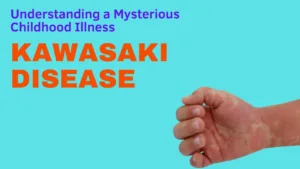Kawasaki Disease: Understanding a Mysterious Childhood Illness

Introduction
Kawasaki Disease is a rare but significant illness that primarily affects children. First identified in Japan by Dr. Tomisaku Kawasaki in the 1960s, this condition remains a mystery to medical professionals. Kawasaki Disease mainly impacts the blood vessels, particularly those found in the heart. Although it can be a serious illness, early diagnosis, and treatment can greatly improve the outcome. In this article, we will explore the various aspects of Kawasaki Disease, including its symptoms, diagnosis, treatment, prevention, and the challenges faced by those living with the condition.
What is Kawasaki Disease?
Kawasaki Disease, also known as Kawasaki syndrome, is an inflammatory illness that predominantly affects children under the age of five. Its exact cause remains unknown, although it is speculated to involve a combination of genetic and environmental factors. The disease leads to inflammation in the walls of medium-sized arteries throughout the body, including the coronary arteries that supply blood to the heart muscles.
Signs and Symptoms
The symptoms of Kawasaki Disease can vary from child to child, making it challenging to diagnose. Some common signs include prolonged fever, rash, red eyes, swollen hands, and feet, swollen lymph nodes, and redness or dryness of the lips and tongue. Children may also experience irritability, joint pain, and peeling of the skin on their fingers and toes.
Diagnosis
Diagnosing Kawasaki Disease can be a complex process, as there is no specific test available. Instead, healthcare professionals rely on a combination of clinical observations and the presence of specific symptoms over a period of time. Blood tests, echocardiograms, and other imaging techniques are often utilized to rule out other conditions and evaluate the impact of the disease on the coronary arteries.
Treatment Options
The primary goal of treatment for Kawasaki Disease is to reduce inflammation and prevent complications, particularly damage to the coronary arteries. Intravenous immunoglobulin (IVIG), a solution containing antibodies, is commonly administered to help reduce inflammation and improve outcomes. Additional treatment may include aspirin therapy to reduce the risk of blood clots and alleviate fever.
Complications and Long-Term Effects
If left untreated, Kawasaki Disease can lead to serious complications, primarily affecting the heart. Coronary artery aneurysms, which are abnormal bulges in the blood vessels of the heart, are the most severe long-term effect. These aneurysms can lead to heart attacks, heart valve problems, and other cardiovascular issues. Prompt diagnosis and appropriate treatment greatly reduce the risk of long-term complications.
Kawasaki Disease Prevention
Since the cause of Kawasaki Disease is unknown, there are no specific prevention methods. However, early detection is crucial to minimize the risk of complications. Parents should be aware of the symptoms and seek medical attention if their child exhibits prolonged fever and other Kawasaki Disease indicators. Timely treatment can make a significant difference in the outcome.
Research and Advancements
The medical community continues to explore the underlying causes and treatment options for Kawasaki Disease. Ongoing research aims to identify the factors triggering the disease and develop more effective therapies. Scientists are also investigating the potential genetic predisposition and the role of infectious agents in Kawasaki Disease. Collaborative efforts worldwide strive to improve our understanding and management of this perplexing condition.
Living with Kawasaki Disease
Families with children diagnosed with Kawasaki Disease often face challenges related to ongoing medical care and potential long-term effects. Regular follow-up visits with healthcare providers are essential to monitor heart health and manage any associated complications. Emotional support and access to resources, such as support groups, can greatly assist families in coping with the impact of the disease.
Conclusion
Kawasaki Disease remains a mysterious and complex illness that primarily affects young children. Although the exact cause remains unknown, early diagnosis and treatment are key to preventing complications and long-term effects. Healthcare professionals and researchers worldwide are committed to unraveling the mysteries surrounding this disease, improving diagnostic methods, and enhancing treatment options. By raising awareness and supporting affected families, we can contribute to a better understanding and management of Kawasaki Disease.
FAQs
1. Can adults get Kawasaki Disease? Kawasaki Disease primarily affects children under the age of five, but it can occasionally occur in older children and adults.
2. Is Kawasaki Disease contagious? No, Kawasaki Disease is not contagious and cannot be spread from one person to another.
3. Are there any known risk factors for Kawasaki Disease? While the exact cause is unknown, some studies suggest that certain genetic factors and infections may contribute to the development of Kawasaki Disease.
4. Can Kawasaki Disease recur? In rare cases, Kawasaki Disease can recur. Close monitoring and regular follow-up with healthcare providers are crucial for early detection and management.
5. Is there a vaccine for Kawasaki Disease? Currently, there is no vaccine available to prevent Kawasaki Disease. Early diagnosis and prompt treatment remain the best approach to minimize complications.
Also, Visit: Health and Wellness